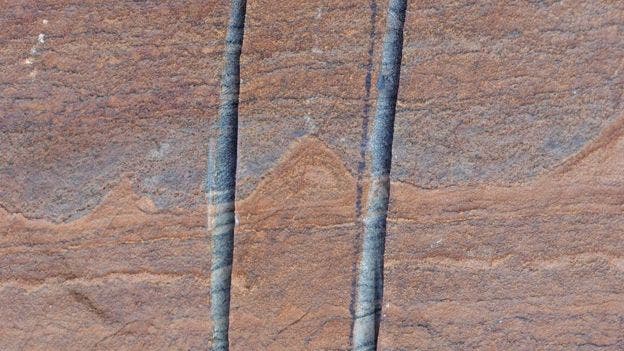Two years ago, researchers at the University of Wollongong in Australia caused quite a commotion when they claimed that 3.7-billion-year-old fossils found in Greenland rocks represent the oldest evidence for life. What the researchers found was assumed to be not fossilized life per se, but rather structures called stromatolites made by bacterial colonies — a type of biological “footprint”. But an independent research team that verified the findings turned up with something different: they concluded that the ancient carvings in the rock are not biological at all.
The alleged stromatolites were recovered from the Isua supracrustal belt in southwest Greenland, which is home to some of the oldest rocks ever, extending up to 4.2 billion years old. Isua rocks are metamorphic — sedimentary rocks that were subjected to extreme temperature and pressure, changing dramatically in the process. Because such conditions are known to deform the original rock, critics were concerned that the stromatolite fossils — if there were any genuine ones in the first place — had been altered.
Scientists could not find any biosignatures or organic chemical compounds but the cone-shaped structures, measuring 1 and 4 cm (0.4 and 1.6 in) in height, were seen as enough proof of ancient biological activity. Stromatolites are formed by colonies of bacteria that slowly and gradually stack fine layers of sediments atop of each other, forming a column-like structure.
In their 2016 study, Australian researchers wrote that they had ruled out all other possibilities and that the stromatolites likely seem the oldest evidence for life on Earth. Skeptical, as all scientists should be, Abigail Allwood, a geologist from the California Institute of Technology and Minik T. Rosing, a geochemist at the University of Copenhagen, traveled to the Isua site to study the rocks.
The team performed a complex analysis of the samples, studying them from the front and sides, and found that the structures showed signs of both compression and expansion. This suggests that the structures were shaped by surrounding rock, not internal biological activity. What’s more, when the researchers performed a 3-D observation analysis, the structures were not cone-shaped anymore but rather looked like ridges. In other words, the structures were not forged by creatures but by tectonic processes. The fact that the region of Greenland where the structures were found is very geologically active seems to add weight to the new study’s conclusions, whose findings appeared in Nature.
Geologist Allen Nutman, who led the team at the University of Wollongong, is still standing by his initial assessment pointing to stromatolites and claims the new study fails to provide enough evidence to the contrary.
“This is a classic comparing apples and oranges scenario, leading to the inevitable outcome that ours and their observations do not exactly match,” Nutman told Gizmodo. “Allwood never took up the offer made by our team to lend our samples to them, so they could make an independent assessment of the best-preserved original specimens.”
Perhaps further analysis might help finally settle the affair. Meanwhile, seeing how the Greenland stromatolites are challenged, the next oldest evidence for life that scientists have found dates back to 3.45 billion years ago. However, using a different approach based on DNA ‘molecular clock’, scientists say that life first appeared on Earth even earlier — around 4.5 billion years ago.










